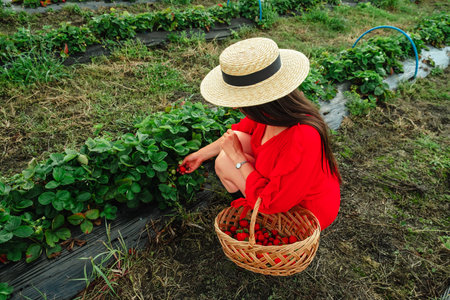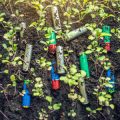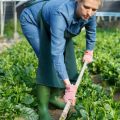1. Choosing the Right Location
Starting a garden is exciting, but before you plant a single seed, it’s important to pick the right spot in your yard. The success of your garden depends a lot on its location. Here are the three key things to consider: sunlight, soil drainage, and accessibility.
Sunlight
Most vegetables and flowers need at least 6 to 8 hours of direct sunlight per day. Watch how the sun moves across your yard throughout the day to find areas that get full sun.
Sunlight Needs for Common Plants
| Plant Type | Sunlight Requirement |
|---|---|
| Tomatoes | 6–8 hours (Full Sun) |
| Lettuce | 4–6 hours (Partial Sun) |
| Roses | 6+ hours (Full Sun) |
| Hostas | 2–4 hours (Shade/Indirect Light) |
Soil Drainage
Your garden soil should drain well but still hold enough moisture for roots to absorb water. Avoid areas where water pools after rain, as too much moisture can rot your plants’ roots.
How to Test Your Soil Drainage
- Dig a hole about 12 inches deep and wide.
- Fill it with water and let it drain completely.
- Refill it again and time how long it takes to drain.
If the water drains within 1–2 hours, its good. If it takes longer than 4 hours, choose another spot or improve drainage.
Accessibility
Your garden should be easy to reach so you’ll be more likely to care for it regularly. Choose a spot near a water source and close enough to your house so you can keep an eye on it. Think about how easy it will be to bring tools, compost, or harvest your crops.
Quick Tips for Accessibility
- Near Water: Make sure you can easily connect a hose or carry water cans.
- Flat Ground: Avoid steep slopes unless youre terracing.
- Visible Spot: A garden you see often is one you’ll tend more often.
Choosing the best location sets your garden up for success from day one. Take time to observe your yard and pick a spot that meets all three criteria: sunlight, good drainage, and easy access.
2. Understanding Your Zone and Soil
Before you start planting, its essential to understand your local climate and soil conditions. These factors greatly affect what plants will thrive in your garden. In this section, well guide you through finding your USDA Hardiness Zone and how to test and improve your soil for the best gardening results.
Discover Your USDA Hardiness Zone
The USDA Hardiness Zone Map helps gardeners determine which plants are most likely to thrive at a location based on the average annual minimum winter temperature. The United States is divided into 13 zones, each representing a specific range of temperatures.
Why It Matters
Your zone determines what perennials will survive the winter and when to plant vegetables or flowers. Choosing plants suited for your zone increases your chances of success.
How to Find Your Zone
You can easily find your USDA Hardiness Zone by entering your ZIP code on the official USDA website or using online garden planning tools.
| Zone | Temperature Range (°F) | Example Cities |
|---|---|---|
| Zone 3 | -40 to -30 | Duluth, MN |
| Zone 5 | -20 to -10 | Chicago, IL |
| Zone 7 | 0 to 10 | Nashville, TN |
| Zone 9 | 20 to 30 | Sacramento, CA |
Get to Know Your Soil
Your soil is the foundation of your garden. Knowing its type and condition will help you grow healthy plants with strong roots.
Types of Soil
The main types of soil are:
- Sandy: Drains quickly but doesnt hold nutrients well.
- Clay: Holds water but drains poorly; heavy and compact.
- Silty: Smooth and fertile but can compact easily.
- Loamy: A balanced mix of sand, silt, and clay—ideal for most gardens.
How to Test Your Soil
You can buy a soil testing kit from a garden center or send a sample to your local cooperative extension office. Testing tells you about pH levels (how acidic or alkaline the soil is) and nutrient content like nitrogen, phosphorus, and potassium.
Simple DIY Soil Test
- Scoop up some soil from about 6 inches deep in multiple spots in your yard.
- Mix the samples together in a clean container.
- Add water and let it settle overnight. Observe the layers that form—sand settles first, then silt, then clay.
Tips to Improve Your Soil
- Add compost regularly to boost nutrients and improve texture.
- Avoid walking on garden beds to prevent compaction.
- If drainage is poor, consider raised beds or mixing in organic matter like peat moss or aged manure.
Taking the time to understand your zone and soil will set you up for gardening success. With this knowledge, you’ll be able to choose the right plants and provide them with a strong foundation for healthy growth.
![]()
3. Planning Your Garden Layout
Before you grab your shovel and start digging, it’s important to plan how your garden will look and function. A smart layout helps your plants thrive and makes gardening more enjoyable. Let’s go over three popular garden styles—raised beds, in-ground plots, and container gardens—and how to space everything out properly.
Choosing the Right Garden Style
Raised Beds
Raised beds are perfect if you have poor soil or want easier access without bending too much. They warm up faster in spring and allow for better drainage. You can build them with wood, bricks, or even recycled materials.
In-Ground Plots
This traditional method involves planting directly into the ground. Its budget-friendly and ideal if you have healthy native soil. Just make sure to test and amend your soil as needed before planting.
Container Gardens
If youre short on space or have a patio or balcony, container gardening is a great option. Choose large enough pots with good drainage holes, and use high-quality potting mix for best results.
Garden Style Comparison
| Garden Style | Best For | Pros | Cons |
|---|---|---|---|
| Raised Beds | Poor soil areas, small yards | Good drainage, easier access | Takes time and money to build |
| In-Ground Plots | Larger spaces with decent soil | Low cost, traditional feel | Might need heavy soil prep |
| Container Gardens | Apartments, patios, beginners | Portable, space-saving | Limited root space, dries out faster |
Mapping Out Your Garden Space
No matter which type you choose, spacing is key. Crowding plants can lead to disease and poor yields. Use seed packets or plant tags as a guide—they often list how far apart to space each plant.
Tips for Spacing:
- Create walking paths: Leave at least 18-24 inches between rows or beds so you can move around easily.
- Tall plants go north: Position taller crops like tomatoes or corn on the north side so they don’t block sunlight from shorter ones.
- Sow in blocks: Instead of long single rows, try square-foot gardening or block planting to maximize space.
- Add room for tools: If you’ll be using wheelbarrows or watering cans, plan space for those too.
A Simple Sample Layout Plan (10×10 ft Garden)
| Section | Crops | Description |
|---|---|---|
| Northern row (back) | Corn or sunflowers | Tall crops that won’t shade others when placed at the back. |
| Middles rows | Tomaotes, peppers, beans | Main crop area with mid-height plants spaced 12–18” apart. |
| Southeast corner (front) | Lettuce, radish, herbs | Sensitive crops that benefit from some shade during hot afternoons. |
| Borders/edges | Marigolds or basil | Pest-repelling companion plants that also add color. |
A well-thought-out garden layout helps reduce maintenance time and boosts your harvest. Take your time to measure and sketch your plan before planting—it’ll pay off all season long!
4. Choosing Plants for Beginners
Now that you’ve picked your garden spot and prepared the soil, it’s time to choose what to grow. As a beginner, it’s important to start with plants that are easy to care for, grow well in your USDA Hardiness Zone, and fit your lifestyle and goals. Whether you want fresh veggies for your kitchen, herbs for cooking, or colorful flowers to brighten up your yard, picking the right plants will set you up for success.
Know Your Growing Zone
The first step is to find out your USDA Hardiness Zone. This map divides the U.S. into zones based on average low temperatures. Knowing your zone helps you pick plants that can thrive in your climate. You can look up your zone by entering your ZIP code on the USDA website or checking a local garden center.
Pick Plants That Match Your Lifestyle
Think about how much time you can spend in the garden and what kind of maintenance youre comfortable with. If youre busy or new to gardening, choose low-maintenance plants that don’t need constant attention. Also consider how much sunlight your garden gets—some plants love full sun while others prefer partial shade.
Beginner-Friendly Vegetables
If youre looking to grow your own food, start with these easy-to-grow vegetables:
| Vegetable | Best Growing Conditions | Why Its Beginner-Friendly |
|---|---|---|
| Lettuce | Cool weather, partial shade | Grows fast, harvest often |
| Radishes | Full sun, well-drained soil | Matures quickly (under a month) |
| Zucchini | Full sun, warm weather | High yield with little effort |
| Green Beans | Full sun, regular watering | Tolerant and productive |
| Tomatoes (cherry type) | Full sun, rich soil | Disease-resistant options available |
Easy Herbs to Grow at Home
If you love cooking or want fragrant plants near your kitchen window or patio, herbs are a great choice. Here are a few popular options:
- Basil: Loves warmth and sun; perfect for summer dishes.
- Mint: Grows fast; best in containers since it spreads quickly.
- Parsley: Tolerates part shade; good for garnishes and cooking.
- Chives: Hardy and low-maintenance; adds mild onion flavor.
- Cilantro: Great for cooler seasons; used in many cuisines.
No-Fuss Flowers for Instant Color
If you’re more interested in adding beauty to your outdoor space, go with flowers that are tough yet stunning. Try these beginner-friendly blooms:
- Marigolds: Bright colors, pest-repelling properties, thrives in full sun.
- Zinnias: Heat-tolerant annuals with vibrant colors.
- SUNflowers: Easy to grow from seed; dramatic height and cheerful blooms.
- Pansies: Cool-season favorites with friendly faces and varied colors.
- Coneflowers (Echinacea): Perennials that attract pollinators and resist drought.
Selecting Based on Your Goals
Your plant choices should reflect what you want from your garden. Do you want homegrown produce? Fresh herbs at arm’s reach? Or just a beautiful backyard view? Once you define your goals—whether its saving money on groceries or creating a relaxing outdoor retreat—it becomes easier to narrow down the best plant choices for your needs.
A Quick Plant Selection Checklist for Beginners:
- Did I check my USDA Hardiness Zone?
- Does this plant match my sunlight and watering conditions?
- Is this plant known to be easy to grow?
- Does it align with my gardening goals (food, beauty, pollinators)?
- Am I excited to care for this plant?
Selecting the right plants is one of the most exciting parts of starting a garden. With the right choices, you’ll not only enjoy gardening more—you’ll also see better results right from the beginning!
5. Essential Tools and Supplies
Before you start planting, its important to gather the right tools and supplies. Having the proper equipment on hand can make gardening easier, more enjoyable, and help your garden thrive from the beginning. Heres a beginner-friendly checklist of must-have gardening tools and supplies to set you up for success.
Basic Gardening Tools
These essential tools will help you with digging, planting, weeding, and maintaining your garden:
| Tool | Purpose |
|---|---|
| Garden Trowel | Perfect for digging small holes, transplanting seedlings, and removing weeds. |
| Hand Rake or Cultivator | Loosens soil and removes debris from small areas. |
| Pruning Shears | Used to trim and shape plants or cut back dead growth. |
| Watering Can or Garden Hose with Nozzle | Keeps your plants hydrated; choose a nozzle that allows for gentle watering. |
| Gloves | Protects your hands from dirt, thorns, and blisters. |
| Garden Fork | A helpful tool for turning soil and breaking up clumps. |
| Spade or Shovel | Great for digging larger holes and moving soil or compost. |
Helpful Gardening Supplies
Apart from tools, youll need some basic supplies to get started:
| Supply | Description |
|---|---|
| Seeds or Starter Plants | Select vegetables, herbs, or flowers based on your region and season. |
| Pots or Containers (if container gardening) | An option if youre growing on patios or balconies. |
| Soil or Potting Mix | The foundation of a healthy garden; choose a quality mix suited for your plants. |
| Compost or Fertilizer | Nourishes your plants with essential nutrients. |
| Mulch | Helps retain moisture, suppress weeds, and regulate soil temperature. |
Optional but Nice-to-Have Items
- Kneeling pad – Makes it more comfortable to work close to the ground.
- Garden cart or bucket – Handy for carrying tools or harvesting produce.
- Plant markers – Helps you remember what youve planted where.
This list will give you a strong start as you build your garden. As you gain experience, you might find additional tools that fit your specific needs. But with these basics in hand, youre ready to dig in!
6. Planting, Watering, and Maintenance Tips
Once your garden beds are ready and you’ve chosen the right plants for your space, it’s time to get your hands dirty! This section walks you through how to sow seeds, set up a watering routine, manage pests naturally, and care for your garden throughout the seasons.
Sowing Seeds: Step-by-Step
Planting seeds may seem simple, but doing it correctly can make a big difference in how well your garden grows. Follow these steps:
Step 1: Read the Seed Packet
The seed packet tells you everything you need to know—how deep to plant the seeds, how far apart to space them, and when to plant based on your USDA Hardiness Zone.
Step 2: Prepare the Soil
Loosen the top few inches of soil with a hand trowel or rake. Remove any weeds or rocks so seeds have room to grow.
Step 3: Sow Your Seeds
Use your finger or a stick to create shallow holes. Drop in one or two seeds per hole, then lightly cover them with soil. Gently pat down the surface.
Step 4: Water Lightly
Mist the soil with water using a spray bottle or a watering can with a fine rose head. Avoid overwatering at this stage—just keep the soil moist until seedlings emerge.
Watering Routine: Keep It Consistent
Your garden needs water, but how much depends on your climate, soil type, and what youre growing. Heres a simple guide:
| Plant Type | Watering Frequency | Best Time to Water |
|---|---|---|
| Vegetables | 2–3 times/week | Early morning |
| Herbs | 1–2 times/week | Morning or late afternoon |
| Flowers | Depends on variety (check label) | Morning |
Avoid watering during midday heat as it can cause evaporation loss. Deep watering is better than frequent shallow watering—it encourages roots to grow deeper.
Pest Control: Natural and Simple Methods
You don’t need harsh chemicals to keep bugs at bay. Try these beginner-friendly options:
- Diatomaceous Earth: Sprinkle around plants to deter crawling insects like slugs and ants.
- Neem Oil Spray: Mix with water and spray on leaves weekly to prevent aphids and other pests.
- Basil & Marigolds: Plant these near veggies; they naturally repel harmful insects.
Seasonal Care Tips
Your garden’s needs change with the seasons. Here’s what to do year-round:
| Season | Main Tasks |
|---|---|
| Spring | Sow seeds, prep soil, fertilize early crops |
| Summer | Irrigate regularly, mulch for moisture retention, monitor pests |
| Fall | Cull spent plants, plant cool-season crops like spinach and kale |
| Winter | Add compost, plan next year’s layout, protect perennials with mulch |
Caring for your garden doesn’t have to be complicated. With consistent attention and a little know-how, even beginners can enjoy thriving plants all year long.


